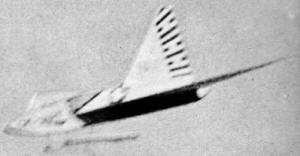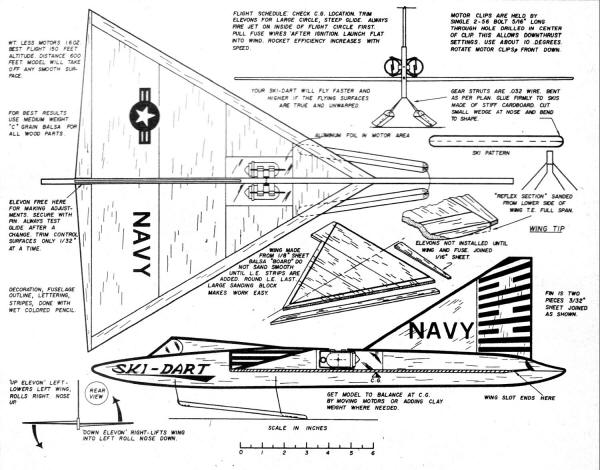|
The Ski-Dart is a twin Jetex 50-powered free flight model that is
patterned after the Convair (maker of the
F-106 Delta Dart) Sea Dart. Simple balsa sheet construction
is used and the only type of finish is using permanent markers for
drawing panel lines, control surface outlines, canopy, etc. Unfortunately,
there are no Jetex or similar (e.g., Rapier) motors or fuel being
produced anymore, so you will either need to find one on eBay, or
possibly use the
1/4A size mini Estes engines.
Ski-Dart for Jetex Power
By Lawrence .H. Conover
 Convair's
experimental Sea Dart was probably the most unusual seaplane ever
to ROW. Your twin jet model, the Ski-Dart, is a going machine. There
is exciting realism in the long takeoff run .... the sudden dip
earthward as the lift breaks down (a basic characteristic of delta
wings due to a flow transition, even on full scale aircraft) ...
a bounce back into the air, both jets blasting ... Fast low-angle
climb to altitudes of 100' ... smooth flare-over as power dies ...
a fighter-like glide to the far end of the field. Convair's
experimental Sea Dart was probably the most unusual seaplane ever
to ROW. Your twin jet model, the Ski-Dart, is a going machine. There
is exciting realism in the long takeoff run .... the sudden dip
earthward as the lift breaks down (a basic characteristic of delta
wings due to a flow transition, even on full scale aircraft) ...
a bounce back into the air, both jets blasting ... Fast low-angle
climb to altitudes of 100' ... smooth flare-over as power dies ...
a fighter-like glide to the far end of the field.
This is an easy model to construct. First digest the plans thoroughly.
Make wing board a bit oversized; do not layout on wax paper;
put glue on both edges of three-inch sheets to be joined; stick
together in midair; lay on flat workbench and rub in glue at joint;
let dry about 3 minutes. Wiggle loose and turn over; add small amount
of glue and rub in; let dry and then continue in same manner. When
dry, draw delta wing shape and cut with a sharp razor blade, using
a straight edge for accuracy. Add leading edge strips; taper completed
wing to 1/16" thickness at tips; don't forget reflex section on
lower trailing edge.
Do all colored-pencil decoration before assembly; do not "paint"
a flying model. The skis and struts, as a completed unit, are cemented
into slots in fuselage; double coat with glue.
Flying is easy if care is taken. Get a straight glide or a very
large circle. The ship will probably have a tendency to turn in
one direction when thrown hard on a hand glide. Note this high-speed
turning, then always light up the motor that is on the inside of
that circle first. Thrust forces act about the C.G. and this little
trick will keep your model in a safe flight pattern. If you pull
fuse wires when the charges ignite (to prevent backfiring and loss
of power) wet your fingertips first!
Your Ski-Dart will take off any surface it can skid on. This
model was designed oversize and heavy for easy flying. If you have
success with this version, you might wish to try a lightweight ship
using thinner and lighter balsa. But be careful - it's hot!

Ski Dart for Jetex Power Plans
Notice:
The AMA Plans Service offers a
full-size version of many of the plans show here at a very reasonable cost. They
will scale the plans any size for you. It is always best to buy printed plans because
my scanner versions often have distortions that can cause parts to fit poorly. Purchasing
plans also help to support the operation of the
Academy of Model Aeronautics - the #1
advocate for model aviation throughout the world. If the AMA no longer has this
plan on file, I will be glad to send you my higher resolution version.
Try my Scale Calculator for
Model Airplane Plans.
Posted June 4, 2014
|